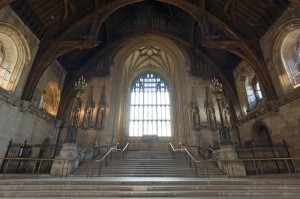
On 12th May 1536, Sir Henry Norris, Sir Francis Weston, William Brereton and Mark Smeaton were brought before a special commission of oyer and terminer at Westminster Hall and arraigned for high treason. Smeaton pleaded “guilty”, while the others pleaded “not guilty”.
Although the jury included Thomas Boleyn, Earl of Wiltshire, who would certainly not benefit from these men being found guilty when it would prejudice the trial of his son and daughter, many other members can be described as “hostile”. Even Sir William Fitzwilliam, the man who had interrogated Mark Smeaton and who claimed that he had persuaded Norris to confess, was on the jury.
The hostile jury was not the only problem. In Tudor times, defendants did not have counsel and were unaware of what evidence was being presented against them. It was impossible for them to prepare a defence and all they could do was react to what was said in court. The onus was also on them to prove their innocence, rather than the prosecution to prove their guilt. Eustace Chapuys, the imperial ambassador, reported that “Only the groom confessed that he had been three times with the said putain and Concubine. The others were condemned upon presumption and certain indications, without valid proof or confession”, so it does not sound like the prosecution had much of a case. However, Norris, Weston, Brereton and Smeaton really had no chance and it is not surprising that all four were found guilty on all charges, declared traitors and sentenced to the usual traitor’s death, to be hanged, drawn and quartered at Tyburn.
You can read about the men who made up the jury in my article 12 May 1536 – 4 Men and a Trial.
Notes and Sources
- Schauer, Margery S. and Frederick. Law as the Engine of State: The Trial of Anne Boleyn, Wm. & Mary L. Rev. 49 (1980)
- L&P, x.908, Letter from Chapuys to Charles V, 19th May 1536
Photo of Westminster Hall from iStock.